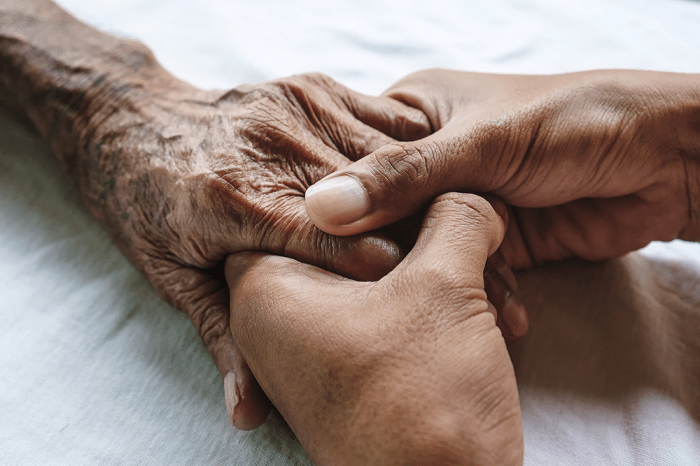
Support for families during end-of-life is a multifaceted and deeply human experience. This exploration delves into the emotional, practical, spiritual, medical, legal, and societal aspects of navigating this challenging period. We will examine the various stages of grief, the crucial role of support networks, and the resources available to families facing the loss of a loved one. The aim is to provide a comprehensive overview of the support systems and practical guidance needed during this difficult time, offering insights into effective coping strategies and fostering a better understanding of the complexities involved.
Emotional Support for Grieving Families
The death of a loved one is a profoundly challenging experience, leaving families grappling with a complex array of emotions. Providing effective emotional support during this difficult time is crucial for facilitating healthy grieving and promoting long-term well-being. Understanding the stages of grief, implementing supportive group structures, and offering practical coping mechanisms are key components of this process.
Stages of Grief
Grief is not a linear process; individuals experience it uniquely and at their own pace. However, several common stages are often identified. These stages, while not universally experienced in this order or by everyone, provide a framework for understanding the emotional landscape of bereavement. It’s important to remember that there is no “right” way to grieve.
- Denial: Initially, individuals may struggle to accept the reality of the loss, experiencing shock and disbelief. This is a natural defense mechanism allowing time to process the overwhelming information.
- Anger: As the reality of the loss sets in, anger may surface, directed towards oneself, others, or even a higher power. This anger is often a manifestation of pain and frustration.
- Bargaining: Individuals may attempt to negotiate with fate, hoping to undo the loss or change the outcome. This stage often involves “what ifs” and unspoken pleas.
- Depression: A profound sadness and sense of loss typically follow. This stage can involve withdrawal, lethargy, and difficulty functioning.
- Acceptance: Eventually, a sense of acceptance emerges, although the pain of loss may persist. This stage involves adapting to life without the deceased loved one.
Support Group Structure
Support groups offer a safe and empathetic environment for grieving families to share their experiences and connect with others facing similar challenges. A structured approach can enhance the effectiveness of these groups.
Meeting Agenda Example:
- Opening (10 minutes): Check-in, brief icebreaker activity focusing on a positive memory of the deceased.
- Sharing (30 minutes): Guided discussion on a specific theme related to grief (e.g., anger, guilt, memories). Facilitator ensures a safe space for sharing.
- Activity (20 minutes): Mindfulness exercise, creative expression (journaling, art), or sharing coping strategies.
- Closing (10 minutes): Summary of key takeaways, planning for next meeting, and opportunity for individual support.
Coping Mechanisms and Strategies
Navigating intense emotions requires proactive coping strategies. These strategies can help manage the emotional burden of grief and promote healing.
- Allowing oneself to grieve: Suppressing emotions can hinder the healing process. Acknowledging and expressing feelings is crucial.
- Seeking social support: Connecting with friends, family, and support groups provides comfort and a sense of community.
- Engaging in self-care: Prioritizing physical and mental well-being through healthy habits (exercise, nutrition, sleep) is essential.
- Practicing mindfulness and meditation: These techniques can help manage anxiety and promote emotional regulation.
- Seeking professional help: Counseling can provide guidance and support in navigating complex grief reactions.
Role of Professional Counselors and Support Networks
Professional counselors offer specialized support, providing a safe space to process emotions, develop coping skills, and address potential complications of grief, such as depression or PTSD. Support networks, including hospices, bereavement centers, and community organizations, provide additional resources and avenues for connection. They offer practical assistance alongside emotional support, bridging the gap between immediate needs and long-term healing.
Practical Support and Resources: Support For Families During End-of-life
Navigating the end-of-life journey is challenging, both emotionally and practically. Families often face a complex web of decisions and responsibilities during this difficult time. Understanding the available resources and planning ahead can significantly ease the burden and allow families to focus on supporting each other. This section Artikels essential practical support and resources available to families facing end-of-life situations.
Financial Assistance Programs and Legal Aid
Financial burdens can significantly compound the stress during end-of-life care. Many organizations offer financial assistance programs to help families cover medical expenses, funeral costs, and other related expenditures. Legal aid is also crucial for navigating complex estate planning and probate processes.
- Social Security Administration: Provides survivor benefits to eligible family members.
- Medicaid and Medicare: Offer coverage for medical expenses, depending on eligibility criteria.
- Hospice care providers: Often provide financial assistance programs for their patients.
- Local charities and non-profit organizations: Offer various financial aid programs for end-of-life care.
- Legal Aid Societies: Provide legal assistance with estate planning, wills, and probate.
It is important to research and apply for these programs early to ensure timely assistance. Eligibility requirements vary depending on the specific program and location.
Funeral Arrangements and Estate Planning
Planning for funeral arrangements and estate matters is a crucial aspect of end-of-life preparation. A well-defined plan can alleviate the burden on the family during an already emotionally challenging time. This step-by-step guide provides a framework for managing these processes.
- Pre-planning: Discuss funeral preferences (e.g., burial, cremation, memorial service) and make arrangements with a funeral home in advance.
- Estate Planning: Create or review a will, power of attorney, and healthcare directive to ensure your wishes are respected.
- Gather Important Documents: Compile all necessary financial and legal documents (bank statements, insurance policies, deeds, wills).
- Notify Relevant Parties: Inform family, friends, financial institutions, and other relevant parties about the death.
- Work with Executors/Administrators: If appointed, work closely with executors or administrators to manage the estate.
This process can be facilitated by consulting with legal professionals and financial advisors.
In-Home Care Options
In-home care offers a valuable alternative to institutionalized care, allowing individuals to remain in the comfort of their homes during their final stages of life. Several options exist, each with varying levels of support and cost implications.
- Home Health Aides: Provide basic personal care, such as bathing, dressing, and meal preparation.
- Registered Nurses: Offer more specialized medical care, including medication management and wound care.
- Hospice Care: Provides comprehensive medical, emotional, and spiritual support for terminally ill individuals.
Costs vary greatly depending on the type and intensity of care needed, as well as the provider. It’s crucial to research and compare different providers and their pricing structures before making a decision. Insurance coverage may also influence the affordability of in-home care.
Managing Household Tasks During Bereavement
The loss of a loved one often leaves families struggling to manage everyday household tasks and responsibilities. Bereavement can lead to exhaustion, emotional distress, and a reduced capacity for handling practical matters.
- Seek Support from Family and Friends: Accept offers of help with chores, errands, and childcare.
- Hire Professional Help: Consider hiring a cleaning service, lawn care professional, or handyman to assist with household maintenance.
- Prioritize Tasks: Focus on essential tasks first, and don’t be afraid to delegate or postpone less urgent matters.
- Utilize Community Resources: Explore local support groups and community resources that can provide assistance with household tasks.
Allowing oneself time to grieve is essential, and seeking help with practical matters allows for a more manageable transition during this difficult time.
Spiritual and Religious Support

For many families, faith and spirituality play a crucial role in navigating the emotional complexities of end-of-life care and bereavement. Belief systems often provide a framework for understanding death, offering comfort, hope, and a sense of meaning during a profoundly challenging time. This support can manifest in various ways, impacting both the individual facing their mortality and their loved ones.Spiritual and religious beliefs offer diverse perspectives on death and dying, shaping rituals, practices, and the overall experience of grief.
These beliefs can provide solace, strength, and a sense of connection to something larger than oneself, helping families cope with loss and find acceptance. Access to appropriate spiritual and religious support is therefore an important aspect of comprehensive end-of-life care.
Diverse Religious and Cultural Traditions Surrounding Death and Dying
Different religious and cultural traditions approach death and dying with unique rituals, beliefs, and practices. For example, in some Christian traditions, last rites or anointing of the sick are common practices offering spiritual comfort and preparation for death. Jewish traditions emphasize mourning rituals like Shiva, a seven-day period of mourning where family and friends gather to offer support and comfort.
Buddhist traditions often focus on meditation, mindfulness, and acceptance of impermanence to help individuals and families navigate the grieving process. Hinduism incorporates cremation ceremonies and remembrance rituals specific to their beliefs. Understanding these diverse approaches is essential for providing culturally sensitive and appropriate support.
Approaches to Spiritual Counseling and Pastoral Care
Spiritual counseling and pastoral care offer distinct yet complementary approaches to supporting grieving families. Spiritual counseling often focuses on exploring the individual’s spiritual beliefs and experiences, helping them find meaning and purpose in the face of loss. Pastoral care, often provided by clergy or religious leaders, integrates spiritual guidance with practical support, offering comfort, prayer, and guidance rooted within a specific religious framework.
Both approaches emphasize empathy, active listening, and creating a safe space for individuals to express their emotions and spiritual concerns. While pastoral care is typically faith-based, spiritual counseling may adopt a more ecumenical or secular approach, catering to individuals with diverse spiritual backgrounds.
Resource Guide for Spiritual and Religious Support
Finding appropriate spiritual and religious support can be challenging during bereavement. Below is a partial list of organizations that provide such support. Note that this list is not exhaustive, and the availability of services may vary by location. It is advisable to conduct further research based on specific religious or spiritual needs and geographical location.
| Organization Type | Example Organization (Note: This is illustrative and actual availability and names vary by location) | Services Offered |
|---|---|---|
| Interfaith Chaplaincy Service | [Local Hospital or Hospice Chaplaincy Service] | Spiritual counseling, pastoral care, interfaith rituals, bereavement support groups. |
| Religious Denomination/Faith-Based Organization | [Local Catholic Diocese, Baptist Church, Synagogue, Mosque, etc.] | Religious services, grief counseling, pastoral visits, community support. |
| Hospice and Palliative Care Providers | [Local Hospice Provider] | Spiritual and emotional support integrated into holistic end-of-life care. |
Medical and Palliative Care Support
Navigating the end-of-life journey requires comprehensive medical and palliative care. This support aims to improve the quality of life for patients facing serious illnesses, focusing on comfort and pain management rather than curative treatments. Understanding the available options and the importance of open communication is crucial for both patients and their families.Palliative care encompasses a range of services designed to address the physical, emotional, and spiritual needs of individuals with life-limiting illnesses.
These services are provided by a multidisciplinary team, including doctors, nurses, social workers, chaplains, and other healthcare professionals. The goal is to alleviate suffering and improve the patient’s overall well-being, allowing them to live as fully as possible until the end of life.
Types of Palliative Care
Palliative care can be provided in various settings, each with its own benefits and limitations. Inpatient palliative care units offer comprehensive, around-the-clock care in a hospital setting, ideal for managing complex medical needs. However, this may limit the patient’s ability to maintain familiar surroundings and relationships. Outpatient palliative care provides support in a clinic or home setting, allowing for greater comfort and familiar surroundings, but might require more family involvement in managing care.
Hospice care, discussed in more detail below, focuses on end-of-life care and is usually provided at home or in a specialized hospice facility. While it provides exceptional comfort and support, it is generally initiated when curative treatment is no longer an option.
Open Communication in End-of-Life Care
Open and honest communication between medical professionals, patients, and families is paramount during end-of-life care. This involves frank discussions about the patient’s prognosis, treatment options, and preferences for care. Sharing information openly helps families make informed decisions, reduces uncertainty, and promotes a sense of shared understanding and control. Effective communication can also foster a stronger patient-family-healthcare provider relationship, improving the overall experience during a difficult time.
For example, regularly scheduled family meetings with the medical team can ensure everyone is on the same page and can address concerns proactively.
Advanced Care Planning, Support for families during end-of-life
Advanced care planning involves making decisions about future medical care in the event that a person becomes unable to make those decisions for themselves. This planning typically includes creating a living will, which Artikels a patient’s wishes regarding medical treatment, and appointing a healthcare proxy, a designated individual authorized to make medical decisions on the patient’s behalf if they become incapacitated.
These legal documents ensure that the patient’s preferences are respected and followed, providing peace of mind for both the patient and their family. A well-structured advanced care plan can help prevent conflict and ensure that care aligns with the patient’s values and beliefs. For instance, a living will might specify a preference for comfort measures only, avoiding aggressive life-sustaining treatments.
The Role of Hospices
Hospices provide specialized care for individuals in the final stages of a terminal illness. They offer a holistic approach, addressing the physical, emotional, spiritual, and social needs of both the patient and their family. Hospice care focuses on pain and symptom management, providing comfort and support to ensure a peaceful and dignified death. Hospice teams work closely with families, offering bereavement support before and after the patient’s death.
The emphasis is on quality of life, enabling patients to spend their remaining time in a comfortable and supportive environment, surrounded by loved ones. Hospice care can be provided in various settings, including the patient’s home, a dedicated hospice facility, or a hospital. For example, a hospice nurse might provide regular visits to administer medication and monitor the patient’s condition, while a social worker could help the family navigate the emotional and practical challenges of end-of-life care.
Death and Dying
Societal perspectives on death and dying are deeply complex and vary significantly across cultures and throughout history. These perspectives shape not only how we approach end-of-life care but also how we grieve and remember those we have lost. Understanding these diverse viewpoints is crucial for providing compassionate and culturally sensitive support to grieving families.
Societal Attitudes Towards Death and Dying Across Cultures and Time Periods
Throughout history, and across diverse cultures, attitudes towards death and dying have been profoundly shaped by religious beliefs, philosophical frameworks, and societal structures. In some cultures, death is viewed as a transition to another realm, often celebrated with elaborate rituals and ceremonies. Examples include the elaborate funeral rites in many Asian cultures, or the Dia de los Muertos celebrations in Mexico, where death is viewed as a natural part of the cycle of life and is commemorated with vibrant festivities.
In contrast, other cultures may emphasize a more subdued approach, focusing on private mourning and remembrance. The Victorian era, for example, saw a strong emphasis on mourning rituals and the preservation of memories, while modern Western societies often strive for a more clinical and less emotionally charged approach to death, particularly within the context of medical facilities. These shifts reflect broader societal changes in values and beliefs.
Approaches to End-of-Life Care and Bereavement Rituals
Different societies approach end-of-life care and bereavement rituals in vastly different ways. Some cultures prioritize keeping the dying person at home, surrounded by family and loved ones, providing comfort and support in their final moments. Others may opt for hospital-based care, focusing on medical interventions and pain management. Similarly, bereavement rituals vary widely. Some cultures involve elaborate funeral processions and ceremonies, lasting for days or even weeks, while others may opt for simpler, more private services.
The role of the family in the grieving process also differs across cultures; some emphasize collective mourning and support, while others may encourage more individualistic approaches. These variations underscore the importance of understanding cultural nuances when providing support to grieving families.
Common Misconceptions and Stigmas Associated with Death and Dying
Several misconceptions and stigmas surround death and dying, often hindering open and honest conversations about end-of-life issues. One common misconception is that discussing death is morbid or taboo. This reluctance to address mortality can lead to families being unprepared for the practical and emotional challenges of end-of-life care. Another stigma involves the perception of those receiving palliative care, often falsely equated with giving up hope or accelerating death.
In reality, palliative care focuses on improving quality of life and providing comfort, regardless of prognosis. Addressing these misconceptions requires promoting open dialogue, education, and a greater understanding of the benefits of advance care planning and palliative care services. Strategies include public awareness campaigns, educational programs, and community initiatives that normalize conversations about death and dying.
Media Representations of Death and Dying
Media portrayals significantly influence public perception of death and dying. The way death is depicted in film, literature, news reports, and other media forms can shape our understanding of mortality, grief, and end-of-life care. These representations often vary widely, from romanticized depictions of peaceful passing to sensationalized accounts of sudden and tragic deaths.
| Medium | Typical Portrayal | Impact on Public Perception | Example |
|---|---|---|---|
| Film | Often romanticized or sensationalized; may focus on dramatic last moments or supernatural elements. | Can create unrealistic expectations about death and dying, potentially leading to disappointment or fear. | Many films depict death scenes with dramatic music and slow motion, often omitting the mundane realities of the dying process. |
| Literature | Can offer diverse perspectives, from realistic depictions of grief and loss to explorations of philosophical questions about mortality. | Provides a platform for exploring complex emotions and ethical dilemmas associated with death. | Works of literature like “A Grief Observed” by C.S. Lewis offer deeply personal and honest accounts of grief. |
| News Media | Often focuses on the immediate aftermath of death, frequently highlighting the tragic or violent aspects. | Can contribute to a fear of death and a lack of understanding of the broader context of end-of-life care. | News coverage tends to focus on sudden and unexpected deaths, neglecting the experiences of those facing prolonged illness. |
Legal and Financial Aspects of End-of-Life Care

Navigating the end-of-life process often involves complex legal and financial considerations that can significantly impact families. Understanding these aspects beforehand can alleviate stress and ensure the wishes of the deceased are honored while protecting the family’s well-being. This section provides an overview of key legal rights, estate planning, insurance coverage, and strategies for managing the financial burdens associated with end-of-life care.
Legal Rights and Responsibilities of Families
Families play a crucial role in end-of-life decisions. Their rights and responsibilities are largely determined by state laws and the individual’s advance directives, such as a living will or durable power of attorney for healthcare. These documents Artikel the individual’s wishes regarding medical treatment and the appointment of a surrogate decision-maker if they become incapacitated. Families generally have the right to be involved in these decisions, to access medical information, and to participate in planning funeral arrangements.
However, the extent of their involvement is often dictated by the existence and clarity of the advance directives. Disputes among family members regarding end-of-life decisions are unfortunately common and may require legal intervention. It’s crucial to have open communication and, ideally, legal counsel to navigate these complexities.
Estate Planning and Probate
Estate planning is the process of preparing for the distribution of assets after death. This involves creating a will, which designates beneficiaries for assets and appoints an executor to manage the estate. A trust can also be established to manage assets and avoid probate, a court-supervised process for validating a will and distributing assets. Probate can be time-consuming and expensive, and the specifics vary widely by state.
The distribution of assets typically follows the instructions Artikeld in the will or trust. If no will exists (intestacy), state laws dictate how assets are distributed, often among surviving spouses and children. Understanding these processes and preparing appropriate legal documents is essential to ensure a smooth transition and avoid potential conflicts among heirs. For instance, a properly drafted will can prevent disputes over inheritances, such as family heirlooms or significant financial holdings.
Insurance Coverage for End-of-Life Care
Various insurance policies can help cover end-of-life expenses. Medicare, Medicaid, and private health insurance policies often cover some costs associated with hospice care, palliative care, and medical treatment. Long-term care insurance can also provide financial assistance for long-term care needs, which may be relevant in the context of end-of-life care. Life insurance provides a death benefit to beneficiaries, which can be used to cover funeral expenses, outstanding debts, and other financial obligations.
It is crucial to review insurance policies and understand their coverage limitations to determine the extent of financial protection available. For example, a policy might cover only a portion of hospice care or require specific documentation for reimbursement.
Managing Financial Burdens of End-of-Life Care
End-of-life care can be financially burdensome, encompassing medical bills, funeral expenses, and potential loss of income for family caregivers. Strategies for managing costs include exploring financial assistance programs, such as Medicaid or charitable organizations. Creating a detailed budget, utilizing savings, and considering life insurance payouts can also help alleviate financial strain. Additionally, open communication with healthcare providers and funeral homes can help negotiate costs and identify potential discounts or payment plans.
For example, a family might choose a less expensive funeral arrangement or opt for cremation instead of traditional burial to reduce expenses. Careful planning and proactive financial management are crucial to mitigate the potential financial impact of end-of-life care.
Ultimately, supporting families during end-of-life requires a holistic approach, addressing the emotional, practical, and spiritual needs of those grieving. By understanding the various stages of grief, accessing available resources, and fostering open communication, we can create a supportive environment that allows families to navigate this challenging journey with greater resilience and peace. The information provided here serves as a starting point for a deeper exploration of this crucial topic, encouraging further research and the development of personalized support strategies for every unique situation.
Common Queries
What are the signs of complicated grief?
Complicated grief involves prolonged and intense sorrow, interfering with daily life. Symptoms may include persistent yearning, intrusive thoughts of the deceased, difficulty accepting the loss, and significant functional impairment.
How can I help a grieving friend or family member?
Offer practical support (meals, errands), listen empathetically without judgment, validate their feelings, and encourage professional help if needed. Avoid clichés and pressure to “move on.”
What is the difference between hospice and palliative care?
Palliative care focuses on relieving symptoms and improving quality of life at any stage of a serious illness. Hospice care is a type of palliative care provided at the end of life, typically when a person has six months or less to live.
Where can I find financial assistance for end-of-life expenses?
Contact social services agencies, charities, and government programs. Funeral homes often have resources and information about financial aid options.






